Update: kicad files: 2014-07-23-pulse_stretcher_kicad
A development on pulse stretcher V1.
This circuit is used to stretch a short 10 ns pulse from a photon-counting module to a 100ns long pulse that can be more easily recorded or time-stamped e.g. with the white rabbit fine-delay FMC.
The new circuit is the same LT1711-based design as the old one, with an added buffer (BUF602) on the output. This improves output-load handling because the BUF602 can drive both 50 Ohm and 1 MOhm loads.
The PCB is made to fit a BNC-BNC enclosure by Pomona.
Some testing with an artificial input-pulse from a Keithley 3390 signal-generator..
.. and with the actual PMT-pulse. Note how the 100MHz scope produces nice round smooth signals while the 500 MHz Tektronix reveals more of the ugly truth.
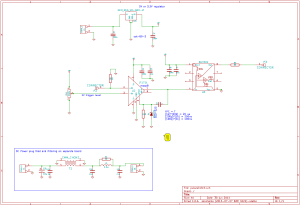
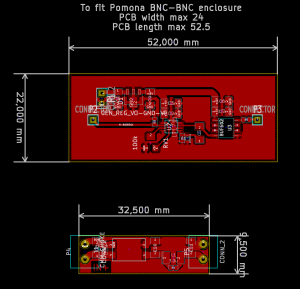
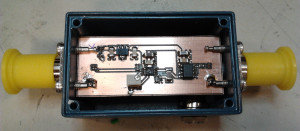
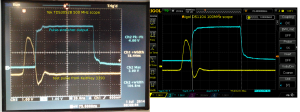
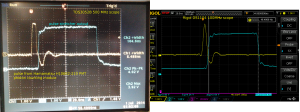
Thanks, good job with kicad,
Cans I ask you to send me this kicad project , I try to do the same thing with LTC6752
Thanks you very much.
I have update the post with a link to a zip file with the kicad project, schematic, and PCB. hope this helps.
Hi! Thank you for posting this, I am also detecting optical signals and need to stretch the pulse for further sampling. I have a question: What happens if the amplitude of the incoming pulse changes? How does that reflect on the stretched pulse?
Thank you.
Hi Oscar, the comparator triggers and produces an output-pulse when the +input goes higher than the trigger-level set with the potentiometer on the -input.
The output-amplitude will be constant for any input-pulse that causes the circuit to trigger. With a low amplitude pulse that stays below the trigger-level you get no output at all.
In this sense all information about the input-pulse amplitude is lost, only timing information from the leading edge of the input-pulse is preserved (although there is some added delay through the stretcher ofcourse). Currently we use an ARTIQ DIO-card for time-stamping PMT pulses that go through this pulse-stretcher.
Hi, Anders
Nice work! What modifications would be required for this pulse stretcher to stretch a 2 ns pulse to 200 ns? We are currently working on the same problem and are looking to extend pulses coming from single photon detectors for digitising at 80 MHz sampling rate. The input pulse is around 50-100 mV.
We've been using this circuit for many years now with the Hamamatsu PMT and time-staming with ARTIQ dio-channel input.
The output-pulse duration should be easily adjustable with the RC timeconstant on the Latch-pin of the comparator.
If you need a precise trigger-level voltage, deriving it from a voltage reference might better than just a potentiometer from the supply rail. There are probably better and faster comparators available, as well as a new faster version of the TI buffer BUF802 - but unless you need extreme performance in terms of rise-time of the edge or timing jitter, the parts I used 10 years ago should work fine.
regards, Anders.